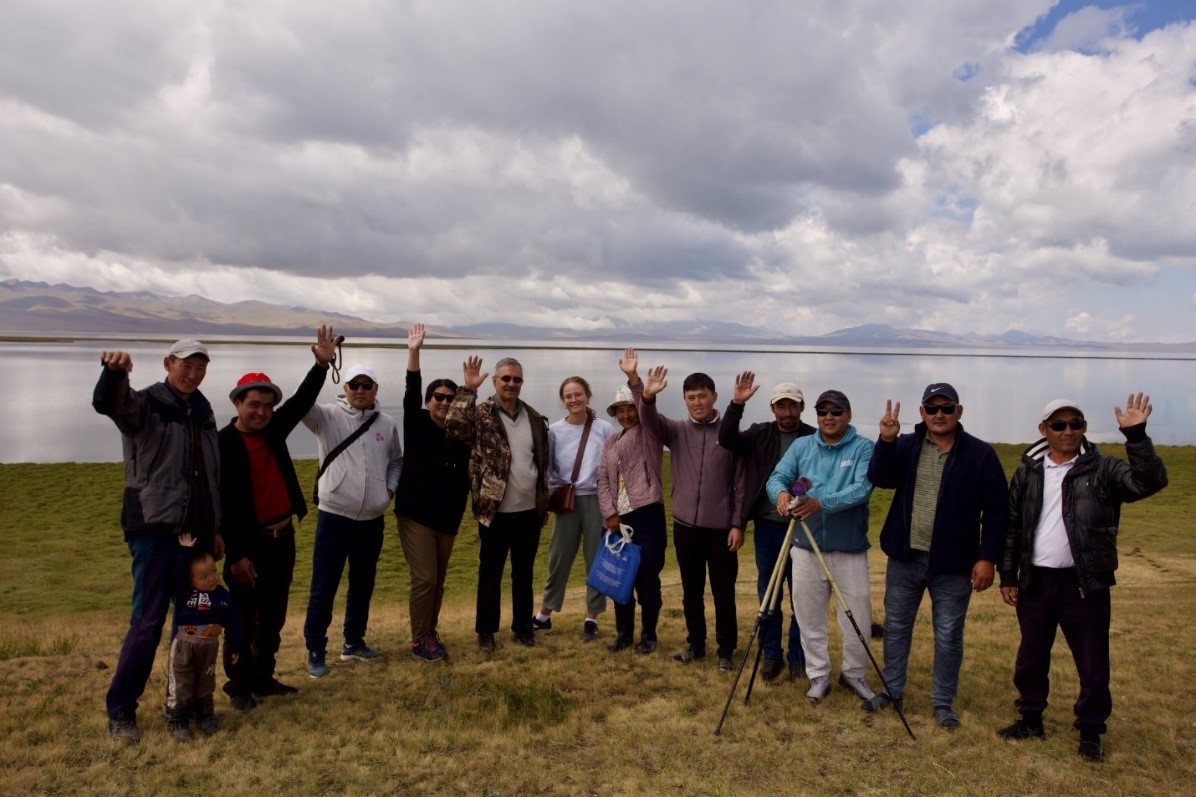A wide educational and informational campaign was conducted on local, regional and national levels. Mapping and monitoring of wetlands and biodiversity of the Son Kul wetland area were conducted by local communities with close collaboration with scientists from the National Academy of Science (NAS). Askar Davletbakov and Myskal Ganybayeva, experts of the National Academy of Science, developed a simplified methodology for biodiversity monitoring (waterfowl, pastures, medicinal herbs, etc.), on the basis of which community-based monitoring of fauna (waterfowl) and flora (plants) with active involvement of local communities of Cholpon municipality.

Local environmental activists worked on identification of the indicator birds of Son-Kul Lake

Community monitoring of water birds of the lake. Son-Kul; Eco-activists and Anatoliy Ostashenko, NAS KR
Mapping was held in the frame of “Securing wetland ecosystems of Son-Kul Lake in the Kyrgyz Mountains” project
The main goal of this project is: "Local communities in northern Kyrgyzstan with a focus on Cholpon rural municipality have their rights acknowledged and respected to sustainably use, govern and preserve natural resources and wetland ecosystems of Son Kul Lake".
Lake Son-Kul has been included in the International List of Wetlands of the Ramsar Convention[1] since 2011. Ramsar sites are recognized as being of significant value not only for the country or the countries in which they are located, but also for humanity as a whole. Lake Son-Kul is of great importance as a nesting and summering place for waterfowl, 131 species were registered, of which - 17 are listed in the Red Book of Kyrgyzstan, 18 - in the Red List of the International Union of Nature Conservation (IUCN), 11 - CITES[2] and 6 - Bonn Convention. A wide variety of birds flies into the Himalayas and for a short time stays around the lake, concentrated mainly in the conservation area. With intensive, uncontrolled grazing in some areas, which leads to the degradation of pastures, the spread of animal diseases, which ultimately leads to threats to waterfowl. Human disturbance and destruction of the natural balance through household waste, extraction of biomass, which directly reduce or worsen wildlife habitat. Illegal fishing, poaching, hunting, especially for birds during molting, also destroys their populations. Ineffective law enforcement and control over human activities, uncontrolled tourists, visits to wildlife and their habitats also lead to degradation.
The state of biodiversity, including wetlands and waterfowl, largely depends on the sustainability of the mountain ecosystems of the pilot area. They play a significant role in soil formation, regulation of runoff in the catchment part of river basins, protection of soil from erosion, cleaning of surface pollution, prevention of floods and mudflows, as well as landslides that cause great economic damage.
Natural capital like natural resources, ecosystems, ecosystem services and climate is the basis for local communities in the project area, who are directly dependent on natural resources and biodiversity. At the same time, local communities in the pilot area are particularly vulnerable to environmental degradation, climate change and disaster risks, chiefly because of their mountainous terrain and sensitive ecosystems, as well as their low adaptive capacity. The project contributed to sustainable use and management of natural resources by raising awareness and strong capacity building interventions based on the right-based/participatory approach provided both to local communities, incl. women, on national, provincial and local levels, so that they have exercised their rights and participate on their own terms in the protection and management of wetlands and their natural resources such as birds, fish, forest and land. This helps mitigate the risks of conflicts over land use by different local communities from neighboring communities who also graze cattle in the Son Kul area.
[1] https://www.ramsar.org/about/wetlands-of-international-importance-ramsar-sites
[2] The Convention on International Trade in Endangered Species of Wild Fauna and Flora







